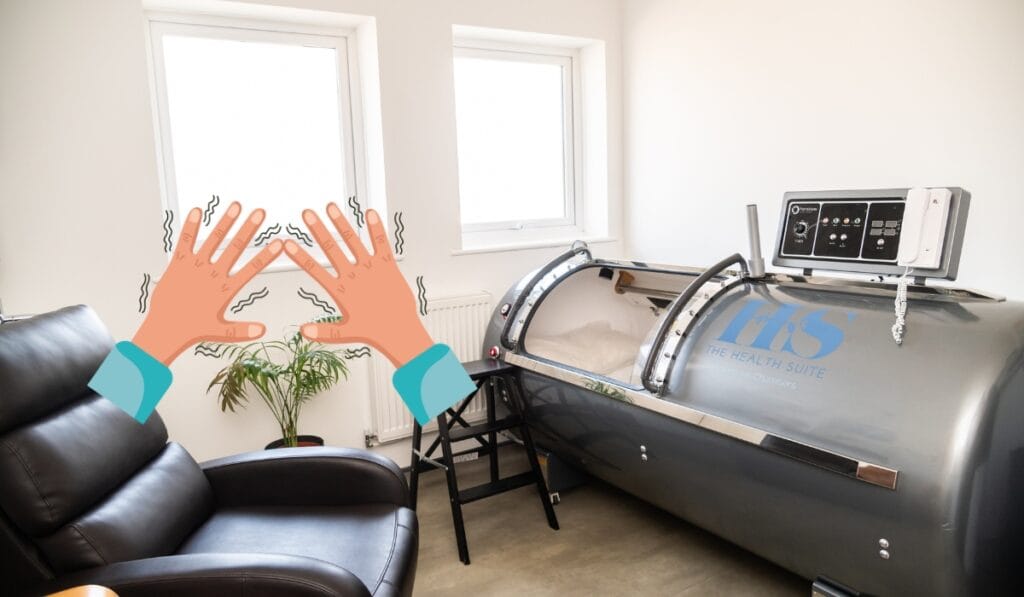Hyperbaric Oxygen Therapy (HBOT) involves breathing 100% oxygen within a pressurised chamber, which enhances oxygen absorption into the bloodstream due to the increased pressure. Traditionally used for conditions like decompression sickness, HBOT is now gaining popularity for treating a variety of other conditions, including neurological disorders.
Understanding Parkinson’s Disease
- Parkinson’s disease (PD) is a chronic neurological condition marked by the progressive loss of dopamine-producing neurons in the brain. This neuronal degeneration results in various symptoms, such as:
- Tremors
- Slowness of movement (bradykinesia)
- Balance problems
- Rigidity in the legs, arms, or body
- Psychiatric disorders
- Loss of facial expression
The reasons an individual may develop Parkinson’s disease are not fully understood, but it is believed to involve several factors: oxidative stress (damage from harmful molecules), cell death, inflammation in the brain, problems with energy production in cells, changes in gene activity, and the buildup of harmful proteins.
Potential Benefits of HBOT for Parkinson’s
HBOT has emerged as a potential treatment for Parkinson’s disease due to its neuroprotective effects. Research suggests that HBOT may reduce oxidative stress and inflammation, both of which are implicated in Parkinson’s disease. Here are some potential benefits of HBOT for Parkinson’s disease:
- Reduction of Oxidative Stress and Inflammation: HBOT can help reduce oxidative stress and inflammation, which are critical factors in the progression of Parkinson’s disease. Read more about Inflammation and Hyperbaric Oxygen Therapy.
- Neuroprotection: Studies indicate that HBOT can increase the levels of enzymes that protect neurons, potentially preventing further neuronal damage.
- Improvement in Motor Symptoms: There is evidence to suggest that HBOT can decrease tremors and improve motor function in Parkinson’s patients.
- Mood and Mental Health Benefits: HBOT has been shown to alleviate depression and anxiety, which are common in individuals with Parkinson’s disease.
Research on HBOT and Parkinson’s Disease
The research on HBOT for Parkinson’s disease, while promising, is still in its early stages. Most studies have been conducted on animal models, with a few case reports and limited human studies available. Here are some key findings:
Animal Studies:
- In studies involving animal models of Parkinson’s disease, HBOT and Madopar, a common PD medication, were tested. Both treatments, individually and together, helped reduce symptoms and protect brain cells.
- HBOT improved movement and muscle strength in mice with Parkinson’s and boosted cellular energy production.
- HBOT prevented the loss of critical brain cells and increased norepinephrine levels, a brain chemical that improved movement.
- In rats, HBOT reduced harmful free radicals and inflammation markers while enhancing protective enzyme activity.
Human Studies:
- Research in humans is limited. One case report showed that HBOT reduced depression and anxiety in a Parkinson’s patient over a 30-day period.
- Another case report indicated small improvements in a patient’s communication and hand function. However, this patient also stopped taking oral medication, and the findings are based on a single case.
- An older study from Russia suggested that HBOT increased the effectiveness of standard treatments, with better results in patients under 65 years of age. However, this study had significant flaws.
Conclusion
While early results are encouraging, more extensive and well-designed studies are needed to establish HBOT’s efficacy and safety for treating Parkinson’s disease in humans. It is important to keep in mind that HBOT for Parkinson’s disease should be used in conjunction with other therapies and is not recommended as a replacement treatment.
Click here to learn more about Hyperbaric Oxygen Therapy and book an appointment.
References
- Atzeni, F., Masala, I.F., Cirillo, M., Boccassini, L., Sorbara, S. & Alciati, A. 2020, “Hyperbaric oxygen therapy in fibromyalgia and the diseases involving the central nervous system”, Clin Exp Rheumatol, vol. 38, no. 123, pp. 94.
- Hoggard, M.L., Johnson, K.E. & Shirachi, D.Y. 2002, “Hyperbaric oxygen treatment on a Parkinson’s disease patient: a case study”, Proceedings of the 14th International Congress of Hyperbaric Medicine, San Francisco, CA.
- Hsu, H., Yang, Y., Chang, W., Fang, W., Huang, S., Chou, S. & Lo, Y. 2022c, “Hyperbaric oxygen therapy improves Parkinson’s disease by promoting mitochondrial biogenesis via the SIRT-1/PGC-1α pathway”, Biomolecules, vol. 12, no. 5, pp. 661.
- Kusuda, Y., Takemura, A., Nakano, M. & Ishihara, A. 2018, “Mild hyperbaric oxygen inhibits the decrease of dopaminergic neurons in the substantia nigra of mice with MPTP-induced Parkinson’s disease”, Neuroscience research, vol. 132, pp. 58-62.
- Mensah-Kane, P. & Sumien, N. 2023, “The potential of hyperbaric oxygen as a therapy for neurodegenerative diseases”, GeroScience, vol. 45, no. 2, pp. 747-756.
- Neretin, V.Y., Lobov, M.A., Kotov, S.V., Cheskidova, G.F., Molchanova, G.S. & Safronova, O.G. 1990, “Hyperbaric oxygenation in comprehensive treatment of Parkinsonism”, Neuroscience and behavioral physiology, vol. 20, no. 6, pp. 490-492.
- Pan, X., Chen, C., Huang, J., Wei, H. & Fan, Q. 2015, “Neuroprotective effect of combined therapy with hyperbaric oxygen and madopar on 6-hydroxydopamine-induced Parkinson’s disease in rats”, Neuroscience letters, vol. 600, pp. 220-225.
- Xu, J., Yang, S., Sha, Y., Ge, Y. & Wang, J. 2018, “Hyperbaric oxygen treatment for Parkinson’s disease with severe depression and anxiety: A case report”, Medicine, vol. 97, no. 9, pp. e0029.
Hyperbaric Oxygen Therapy (HBOT) is a medical treatment that entails breathing pure oxygen in a specially pressurised chamber, which enhances oxygen delivery to tissues, facilitating healing and reducing inflammation.

